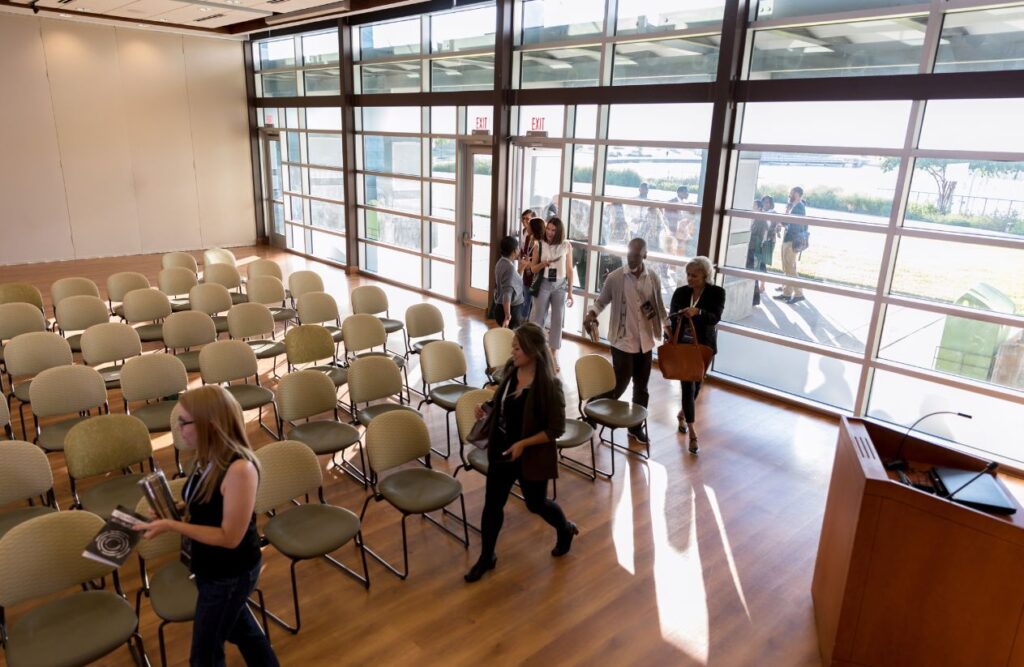Hey there, event planning superstars! Let’s talk about something that often feels like the hidden engine of a great event: venue logistics. It’s not always glamorous, but sorting out the nuts and bolts of your chosen space – from attendee flow to tech hookups – is absolutely crucial for success. Think of it as laying the perfect foundation before you build your event masterpiece.
Getting these details right ahead of time can save you major headaches down the line and genuinely elevate the attendee experience.
That’s why we’ve put together 7 essential venue logistics tips designed to help you navigate the complexities, anticipate potential issues, and leverage smart strategies for a seamless event.
Ready to feel totally in control of your venue on event day? Let’s dive into these tips and build your confidence for flawless execution!
Understanding Your Audience’s Needs & Expectations for the Venue

Alright, tip number one might sound obvious, but stick with me – it’s about digging way deeper than just age and job titles. Truly mastering venue logistics starts with really, really knowing who’s walking through those doors (or logging into that virtual space!).
We’re talking about understanding their motivations for attending, their tech comfort levels, their learning styles, and even their pet peeves when it comes to event spaces.
Think about it: someone attending a cutting-edge tech conference will have vastly different expectations for Wi-Fi speed and charging stations than someone at a crafting workshop.
Someone with mobility challenges needs clear, accessible routes mapped out. Knowing these nuances helps you tailor the physical and digital environment to make them feel comfortable, engaged, and valued.
Beyond Basic Demographics: What Really Matters for Venue Choice?
So, how do you get this insider info? Go beyond basic demographics. Try designing pre-event surveys that specifically ask about venue-related preferences – maybe seating styles they prefer, what tech they expect to use on-site, or any accessibility needs.
Don’t forget to mine past event data or social media comments for clues about what attendees loved (or grumbled about!) at previous venues.
Even registration data can give you a head start on logistics like anticipating the number of vegetarian meals needed for catering or identifying attendees who might require specific seating arrangements.
Leveraging Event Tech to Uncover Venue Insights
This is where event tech really shines as your secret weapon. Use your event app for quick polls about session preferences that might impact room setup, or analyze check-in data to see which areas of the venue are most popular (or overlooked).
Leveraging these tools helps you gather and analyze audience data not just for content planning, but directly for smarter venue logistics decisions.
Also Read:Step-by-Step Guide to Becoming a Successful Event Planner
Strategic Space Optimization: Designing Flow and Functionality

Now that you know who you’re planning for, let’s talk about the space itself. It’s easy to look at a venue floor plan and just think about fitting everyone in.
But true space optimization? That’s an art form! It’s not just about capacity; it’s about creating an environment that enhances the entire event experience – making it easy for people to move around, find what they need, network comfortably, and feel safe. It’s about designing flow and functionality that supports your event goals.
Planning Your Layout Like a Pro
Gone are the days of just sketching on paper (unless you really love that!). Modern event planners lean on digital tools like CAD or specialized event diagramming software. These aren’t just fancy drawing programs; they let you virtually play around with layouts, test different setups, and visualize traffic flow before anything is physically moved.
Think about placing registration areas to avoid bottlenecks, setting up seating arrangements that encourage interaction (or focus, depending on the session!), and ensuring there’s ample space around popular areas like food stations or exhibitor booths. It’s like being a choreographer for people moving through a space!
Tech Tools for Smarter Space Management
This is another area where technology gives you a serious edge. Beyond just planning, you can use tech for analysis and even real-time management. While still evolving, AI can potentially help predict attendee movement patterns based on the schedule and layout, suggesting tweaks to avoid congestion.
During the event, digital signage isn’t just for displaying schedules; interactive maps can help attendees navigate complex venues, reducing wandering and improving flow.
Looking back after the event, data from things like session check-ins or even anonymous Wi-Fi usage patterns (if your tech allows) can offer insights into which areas were most utilized, informing your strategy for the next event.
Adapting for Hybrid Events
And let’s not forget the rise of hybrid events! If you’re blending in-person and virtual components, your physical space needs to adapt. You might need dedicated zones for broadcasting, areas designed for remote participants to interact with those on-site (think video booths or screens), and robust tech infrastructure to support seamless streaming.
Space optimization in a hybrid model means ensuring the physical layout complements the virtual experience, rather than competing with it. It’s a balancing act, but totally achievable with smart planning.
Ensuring Flawless Audiovisual and Technology Setup

Okay, deep breath. Let’s talk tech! Audiovisual (AV) and technology setup is often the most nerve-wracking part of venue logistics for many planners.
It’s not just about having speakers and screens; it’s about ensuring everything works together perfectly, is reliable throughout your event, and genuinely enhances the content, not distracts from it.
Asking the Right Questions About Venue Tech
Before you even sign on the dotted line for a venue, get into the nitty-gritty with their AV team. Don’t be shy! Ask about their in-house equipment – its age, capacity, and compatibility with external gear.
Find out about their internet capabilities: is the Wi-Fi robust enough for hundreds (or thousands!) of attendees simultaneously streaming, using apps, and accessing online content? What’s the backup plan if the internet goes down? Understanding their infrastructure is key to avoiding nasty surprises later.
Crafting a Bulletproof AV Rider
For presenters, performers, or anyone needing specific tech, creating a detailed AV rider is non-negotiable. This document should clearly list exactly what they need – microphone types, projection requirements, sound cues, lighting needs, and any specific software or hardware compatibility.
Share this with the venue and your AV team well in advance. It’s the best way to ensure everyone is on the same page and prevents last-minute scrambles.
The Absolute Necessity of Tech Rehearsals
Seriously, do not skip the tech rehearsal! This is your chance to test everything in the actual space with the actual equipment. Run through presentations, test microphones, check video playback, and ensure sound levels are perfect in different areas of the venue.
- Mini Tech Rehearsal Checklist:
- Test all microphones (lapel, handheld, podium) in different spots.
- Verify all video sources display correctly on all screens/projectors.
- Check audio playback levels and clarity.
- Test presenter clickers and remote controls.
- Confirm internet connectivity is strong in all key areas.
- Walk through any complex lighting or sound cues.
This is where you catch potential issues before the audience arrives.
Planning for the Unexpected (Because It Happens!)
Despite meticulous planning, tech hiccups can occur. That’s why having a plan B (and maybe C!) is part of smart venue logistics. Have dedicated AV technicians on-site throughout the event who know the system inside and out and can troubleshoot quickly.
Keep essential backup equipment readily available – think extra microphones, spare cables, power strips, and adapters for different devices. Knowing common issues (like a presenter’s laptop not connecting) and having a plan to address them minimizes disruption and keeps your event flowing smoothly.

Okay, let’s talk about getting people to your amazing venue and making sure everyone can navigate it comfortably once they’re there.
Transportation and accessibility are two sides of the same coin when it comes to smooth venue logistics – they’re all about removing barriers and making the guest journey as effortless as possible, from their front door to their seat inside.
Smoothing Out the Journey to the Venue
Nobody likes arriving stressed because they couldn’t find parking or figure out the bus route. Providing clear, concise information about how to reach your venue is a must. Think about dedicating a section on your event website or app to transportation options.
Go beyond just listing addresses – include details on public transit routes, links to ride-sharing services, and information about parking availability.
If possible, look into smart parking solutions that allow attendees to pre-book spots or get real-time updates on space availability. Making arrival stress-free sets a positive tone right away.
Designing for True Inclusivity
Accessibility is about much more than just ramps and elevators (though those are non-negotiable!). It’s about considering the needs of attendees with a wide range of abilities – mobility, visual, auditory, cognitive, and sensory.
When planning your venue layout, think about clear pathways, sufficient lighting, and easy-to-read signage.
But also consider things like designated quiet spaces for those who might need a break from sensory overload, or ensuring presentations are accessible with captions or audio descriptions.
Leveraging Tech for Accessibility
Technology can be a huge ally here. Use your event app or digital maps to clearly highlight accessible entrances, routes, restrooms, and seating areas within the venue.
Consider providing digital guides with adjustable text sizes or audio narration. For attendees with hearing impairments, ensure there are options for assisted listening devices or live captioning for sessions. By proactively planning and using tech to communicate these features, you ensure that every attendee, regardless of their needs, feels welcomed and can fully participate. These are crucial venue logistics tips for creating truly inclusive events.
Prioritizing Guest Safety and Venue Security
Now, let’s talk about the absolute non-negotiable: safety and security. This isn’t just a logistical checkbox; it’s a fundamental responsibility that builds trust with your attendees, staff, and everyone involved.
A safe event is a successful event. Period. Thinking through potential risks and having solid plans in place is a core part of effective venue logistics.
Working Hand-in-Hand with Venue and Authorities
Your venue’s security team is your primary partner here. Get to know their protocols, personnel, and capabilities early on. Discuss your event’s specific needs and potential vulnerabilities.
Don’t hesitate to loop in local law enforcement or emergency services if the scale or nature of your event warrants it. Building these relationships and having open lines of communication before event day is invaluable.
Implementing Layered Security Measures
Security isn’t a one-size-fits-all solution. Think in layers. This might include access control points to ensure only registered attendees enter, surveillance systems (CCTV) in key areas, and trained security personnel visible throughout the venue.
The specific measures will depend on your event type, size, and location, but a layered approach provides robust protection.
Developing a Comprehensive Emergency Plan
What happens if something goes wrong? Having a detailed, venue-specific emergency response plan is critical. Think through potential scenarios: fire alarms, medical emergencies, security incidents, or even natural disasters depending on your location.
Your plan should clearly outline evacuation routes, designated safe assembly points, and communication protocols for reaching attendees and staff quickly. Crucially, ensure your staff and volunteers are thoroughly trained on these procedures – practice makes perfect when seconds count.
Don’t Forget Digital Security!
In today’s connected world, venue logistics also means thinking about digital safety. Protecting attendee data collected via registration kiosks or event apps is paramount.
Ensure your event Wi-Fi network is secure and consider advising attendees about the risks of using public Wi-Fi for sensitive transactions.
Briefly understanding data privacy compliance relevant to in-person data collection adds another layer of professionalism and trust. Incorporating robust safety and security measures into your venue logistics tips is essential for peace of mind for everyone.
Also read our article about“Benefits of Planning Your Corporate Event Well in Advance”
Seamless Collaboration with Venue Staff and External Vendors

Okay, we’ve talked about your guests, the space, the tech, getting there, and staying safe. Now, let’s zoom out a bit and talk about the small army of people who help make it all happen: your venue contacts and all your external vendors – catering, decor, AV crews (if separate), rentals, etc.
Smooth coordination with these key players is a venue logistics superpower, often overlooked but absolutely crucial for avoiding chaos on event day.
Establishing Your Communication Hub
Think of yourself as the air traffic controller, and the venue point person is your main tower. Establish clear lines of communication with them early on. Who is your go-to for questions about load-in times? Who handles unexpected issues with the building?
Knowing exactly who to contact for what, and ensuring they know you, is fundamental. This relationship is key to navigating the venue’s rules and capabilities efficiently.
Orchestrating Arrival and Setup
Juggling multiple vendors arriving, setting up, and eventually tearing down can feel like a circus! Create a detailed schedule that coordinates everyone’s access times, delivery windows, and setup requirements.
Share this well in advance with the venue and all vendors. Holding a brief pre-event briefing (even a virtual one) with key vendor contacts can help everyone visualize the timeline and identify potential clashes before they happen on-site.
Staying Connected On-Site
On event day, things move fast. Reliable on-site communication is vital. While event apps can help with schedules and general info, good old-fashioned walkie-talkies or a dedicated event management software with a mobile component can be invaluable for real-time updates between your team, venue staff, and key vendor leads.
Need more chairs in Room B? AV issue in the main hall? Quick communication keeps minor issues from becoming major problems.
Managing Access and Credentials
Finally, make sure vendors know the protocols for accessing the venue, specific areas within it, and any necessary credentials (like wristbands or badges).
This ensures smooth entry for them and maintains the security you’ve worked hard to establish. Clear instructions on where they can park, load/unload, and access service areas are all part of seamless vendor coordination within your venue logistics plan.
Preparing for the Unexpected: Your Venue Backup Plan
Alright, let’s wrap up our essential venue logistics tips with perhaps the most crucial one: planning for when things don’t go exactly according to plan. Because let’s be real, no event is immune to surprises! A sudden power outage, unexpected weather, or even local traffic chaos can throw a wrench in your perfectly laid plans.
That’s why having comprehensive contingency plans is not just smart; it’s absolutely essential for maintaining your cool and ensuring the event can still proceed smoothly, or recover quickly.
Identifying Your Venue’s Specific Risks
Start by thinking about the potential pitfalls specific to your chosen venue and the time of year. Is it prone to power flickers? Are there nearby construction projects that could impact traffic?
Does the weather forecast look questionable for that outdoor reception space? Talk to venue staff about past issues they’ve encountered. Identifying these unique risks is the first step in building effective backup plans.
Developing Backup Strategies for Critical Elements
Once you’ve identified the risks, develop specific backup strategies for the most critical elements of your event. If power is a concern, is there a backup generator available? If you have outdoor components, what’s your indoor alternative, and is it just as appealing? What happens if a key piece of AV equipment fails – do you have a spare or a quick rental option lined up? Thinking through these scenarios and having pre-arranged solutions is key.
Knowing When and How to Pivot
Having plans is one thing; knowing when to activate them is another. Establish clear decision-making protocols before event day. Who has the authority to call for a switch to the indoor backup space?
Who makes the final decision on delaying a session due to a tech issue? Define these roles and triggers in advance so that decisions can be made quickly and confidently under pressure.
Communicating Changes Effectively
If you do need to pivot to a contingency plan, clear and rapid communication is paramount. You need to inform attendees, staff, and vendors about the changes without causing panic.
Use your event app, clear signage, and direct announcements. Being transparent and calm in your communication helps manage expectations and keeps everyone informed during a potentially stressful situation. Mastering these aspects of venue logistics tips ensures you’re prepared for anything!
Conclusion
So there you have it – seven key venue logistics tips to help you navigate the complexities of event spaces.
We’ve covered everything from truly understanding your audience’s needs within the venue to mastering space, tech, transportation, safety, vendor coordination, and crucially, preparing for the unexpected.
Think of these elements not as separate tasks, but as interconnected pieces of a puzzle that form the foundation of a successful event.
Getting these right is your secret weapon for a stress-free planning process and, more importantly, for creating a memorable, seamless experience that your attendees will rave about. Ready to put these insights into action? Go make your next event your most flawlessly executed one yet!
Venue Logistic Tips- FAQ Section
When organizing an event, dealing with venue logistics can often feel like navigating a labyrinth.
To aid in this process, we’ve compiled answers to some of the most common queries that arise during planning. Armed with tech-savvy and professional know-how, let’s tackle these head-ons.
How Can Technology Streamline Venue Selection?
Tech is your friend! Virtual tours save you travel time and let you “visit” multiple venues quickly. Online booking platforms and comparison tools filter options by size, location, price, etc., speeding up your search.
What Are Key Considerations for On-site Logistics Management?
Event management software is a lifesaver – it streamlines registration, check-in, scheduling, and tracking attendees. For large events, RFID wristbands can speed up entry and even grant access to certain areas. Event apps help coordinate staff and communicate updates in real-time.
How to Ensure Seamless Connectivity and Tech Support?
Work with the venue’s IT team well in advance to make sure their network meets your event’s needs (this includes streaming for virtual attendees!). Do a tech rehearsal beforehand to catch problems. Consider hiring dedicated IT support for the event so glitches can be fixed quickly, ensuring a smooth experience for all participants.
By addressing these frequently asked questions with a blend of technology and proactive planning, event planners can navigate venue logistics more smoothly, paving the way for successful and memorable events.






